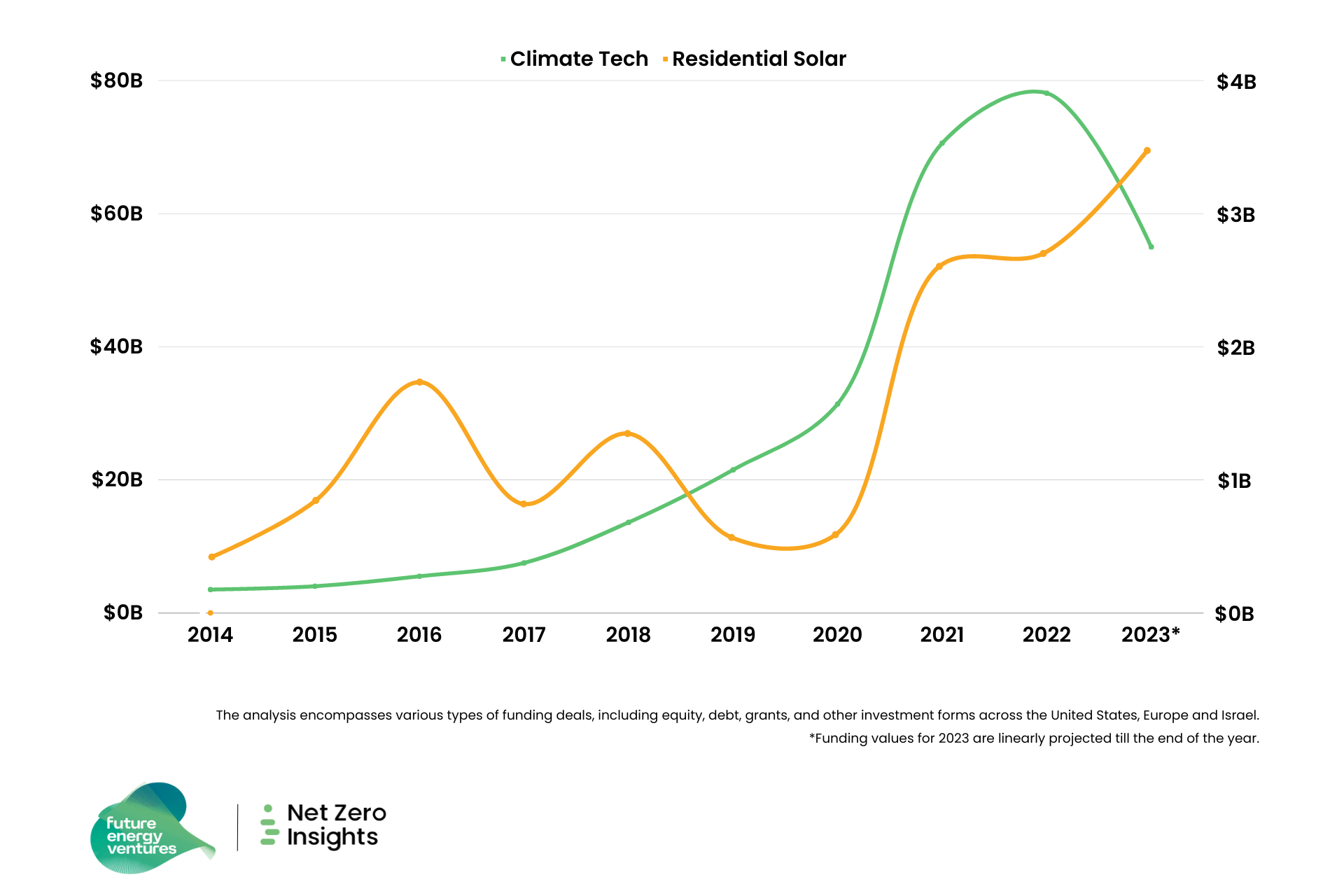
Residential Solar is Driving the Electrification Trend
A deep dive into the venture investment trends of the residential solar space.
By Jan Palasinski and Net Zero Insights
Over the years, residential solar energy has witnessed an astonishing surge in venture investments, growing more than 10x in the last decade. The post-2020 era has been particularly remarkable for residential solar, with 2022 setting records by attracting over $2.6 billion. As we progress into 2023, the trend is on an even more promising trajectory.
While 2022 was an overall positive year for climate tech funding across various sectors, this year has been slower owing to the global economic landscape. Interestingly, residential solar is outperforming the overall climate tech trend in 2023. In partnership with Net Zero Insights, we’ve embarked on a deep dive into venture funding in residential solar across the United States, Europe, and Israel.

Solar energy has been on a remarkable journey, achieving substantial cost reductions, enhanced durability, and improved manufacturing processes. Although solar as a technology has had limited increments in terms of conversion efficiency, the average cost of a residential solar module has dropped from $1/Wp in 2013 to about $0.3/Wp in 2023.
If we zoom out, the most interesting observation is that PV has been the core driver of the electrification of everything trend, enabling other technologies to flourish. Residential solar is not merely about solar panels on rooftops: it’s about how this foundational technology has become the cornerstone for a range of climate-friendly technologies, like energy storage, home EV charging, heat pumps, and Home Energy Management Systems (HEMS). The same growth trend is reflected in the venture funding data across these sectors.

Residential Solar: Paving the Way for Storage Solutions and HEMS.
Residential Solar installations drove an increasing demand for solar PV systems to be paired with battery storage to make the most out of the small power plant on the rooftop. Residential storage recorded a surge in investments especially after 2019, increasing by almost 10-fold to over $2B in 2022.
Furthermore, the introduction of storage solutions led to an increased need for the integration of Home Energy Management Systems (HEMS). HEMS are the architects behind optimizing the entire electricity generation, storage, and consumption process within households while being the foundational elements for price optimization via dynamic electricity tariffs and energy trading. HEMS saw a considerable increase in venture funding from 2021 to 2023, accounting for over $580M in 2022.
As per a report by SEIA/Wood Mackenzie Power & Renewables, by 2027, it is estimated that nearly 30% of all new behind-the-meter solar systems will be paired with storage, a significant increase from under 10% in 2022. Even across FEV’s portfolio in Germany, we can see that it is already close to a 100% bundle rate for new systems installed.
Home EV Charging and Heat Pumps: Simply Following the Lead.
Once solar PV systems are in place, the journey toward electrification becomes an organic progression. Whether it’s fulfilling heating needs or powering electric vehicles, the path is clear. Electric vehicles are essentially batteries on wheels, and adding a home EV charging station enhances the household’s ability to harness self-generated electricity while reducing its grid dependence and saving costs. Home EV charging has seen a 20x jump in funding from $98M in 2019 to $1.8B in 2023 to date.
Similarly, adopting heat pumps is a sensible choice as heating is typically the largest energy consumer in a household. They can be powered by the surplus solar energy generated, which significantly reduces costs and environmental impact. Startups working on heat pumps saw a considerable increase in funding after 2021, on track to reach $1B in 2023.
The Expanding Home Electrification Market: The Solar+ Future
While these technologies are distinct, they work best when integrated, making them essential components of the modern home. This synergy is a testament to the ever-growing residential solar market. Welcome to the Solar+ future.


